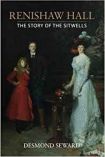Renishaw Hall: the story of the Sitwells by Desmond Seward
| Renishaw Hall: the story of the Sitwells by Desmond Seward | |
|
| |
| Category: Biography | |
| Reviewer: John Van der Kiste | |
| Summary: Seward has told the roller-coaster, sometimes funny and sometimes poignant family history tale very well. Every family which can trace its history back over four hundred years or so can point out a few eccentrics, but not every family can still reside in the original bricks and mortar. The most famous Sitwells may be no more, and the present family may have much to live up to (or alternatively, perhaps, live down) – but, after reading this entertaining account, we can hope that long may they continue to do so. | |
| Buy? Yes | Borrow? Yes |
| Pages: 288 | Date: July 2015 |
| Publisher: Elliott & Thompson | |
| ISBN: 978-1783961832 | |
|
| |
Renishaw Hall, Derbyshire, has been the home of the Sitwells since 1625. Though the history of the house and its family go back to the early Stuart era, as Seward tells us in a few wonderfully concise chapters, it is really with the appearance of the eccentric Sir George Sitwell and his three famous children that the narrative comes into its own.
The Sitwell family, owning one of the largest ironworks in England, originally made their fortune in the Derbyshire nail industry, thanks to George ‘the Cavalier’, an educated man who built the core of Renishaw in 1619. His descendants were shrewd enough to preserve the family fortunes by improving their estates and marrying heiresses. When the male line came to an end with the death of William Sitwell in 1776 the house passed to his nephew, Francis Hurt, who took the Sitwell name and arms by Royal Licence. His son Sitwell Sitwell, the 1st Baronet, was noted for his good taste in architecture and pictures, and also a pack of harriers that killed a Bengal tiger escaped from a circus. When he enlarged Renishaw, built the stables and other outbuildings, he left the estate heavily in debt. His son Sir George, inheriting the debts, and his successor, Sir Reresby, a cornet in the Life Guards and gifted water-colourist, paid the price with the latter trying to sell Renishaw, but failing to find a buyer. His wife Louisa, who had a better head for business and who engaged a shrewd lawyer, saved the property.
Her son George, destined to become the fourth Baronet, is to an extent the pivotal character in the book. He was briefly Liberal MP for Scarborough, though it was an unexceptional political career. A lover of fine gardens, Italian furniture and pictures, and the man who employed the noted portrait painter John Singer Sargent to capture his family on canvas for posterity, he was regarded as the man largely responsible for creating the modern Renishaw. However, after a settled and prosperous era for the family and the estate, as Seward writes, ‘the golden years were turning into lead’. His marriage to Ida, daughter of Lord Londesbrough, proved little short of disastrous. She possessed a certain wounding wit, but shared none of her artistic husband’s interests, had no idea of the value of money, and was an incorrigible spendthrift. In the process of trying to control her he had a nervous breakdown, yet could not save her from getting deeper into debt, falling into the hands of a penniless blackmailer, and ending up in prison for fraud.
Even so, they left their mark on the cultural life of England in producing three children, ‘the trio’ of Osbert, Edith and Sacheverell. It is their lives and achievements which dominate much of the book. Osbert was a pacifist who tried unsuccessfully to follow his father into parliament, but like his siblings he became a noted writer, although their works are read little these days. He is remembered best for his volumes of autobiography, while Edith and Sacheverell were both poets and the former also wrote several works of biography.
Between them, they were not only prolific writers, but also inclined to be eccentric and rather thin-skinned, the butt of put-downs from all directions. One critic complained that they belonged to the history of publicity rather than of poetry, and another wrote to Edith to take her to task for her ‘acid disposition’, to which she retorted that his letter had taught her the value of birth control for the masses. Another paper, reviewing her latest collection of poems in 1941, described them as ‘literary curiosities of the 1920s’, adding that their prominence at that time had been due to self-advertisement, ‘but now oblivion has claimed them’. They sued for libel and were awarded damages and costs. In spite of this, Renishaw remained a magnet for various prominent guests from the cultural world, among them W. Somerset Maugham, Sir Edwin Lutyens, the up-and-coming Evelyn Waugh, and Rex Whistler, who called it ‘the most exciting house in England’.
Osbert was gay and Edith remained a spinster, and it was left to Sacheverell to continue the family line. A postscript notes that his descendants still own the house and gardens, and regular restoration continues to this day. Four centuries after the original dwelling was built, it is being kept alive by present generations, welcoming visitors each year and being seen on TV programmes such as ‘Country File’.
Seward has told the roller-coaster, sometimes funny and sometimes poignant family history tale very well. Every family which can trace its history back over four hundred years or so can point out a few eccentrics, but not every family can still reside in the original bricks and mortar. The most famous Sitwells may be no more, and the present family may have much to live up to (or alternatively, perhaps, live down) – but, after reading this entertaining account, we can hope that long may they continue to do so.
For more on the Sitwells, and other similarly interesting characters over the ages, may we also recommend Curing Hiccups with Small Fires: A Delightful Miscellany of Great British Eccentrics by Karl Shaw.
Please share on: ![]() Facebook,
Facebook, ![]() Twitter and
Twitter and
![]() Instagram
Instagram
![]() You can read more book reviews or buy Renishaw Hall: the story of the Sitwells by Desmond Seward at Amazon.co.uk Amazon currently charges £2.99 for standard delivery for orders under £20, over which delivery is free.
You can read more book reviews or buy Renishaw Hall: the story of the Sitwells by Desmond Seward at Amazon.co.uk Amazon currently charges £2.99 for standard delivery for orders under £20, over which delivery is free.
![]() You can read more book reviews or buy Renishaw Hall: the story of the Sitwells by Desmond Seward at Amazon.com.
You can read more book reviews or buy Renishaw Hall: the story of the Sitwells by Desmond Seward at Amazon.com.
Comments
Like to comment on this review?
Just send us an email and we'll put the best up on the site.


